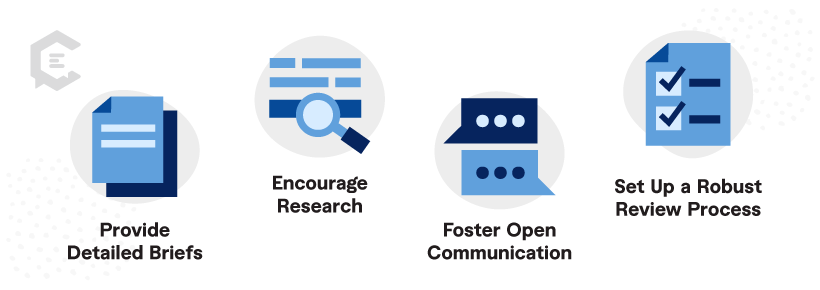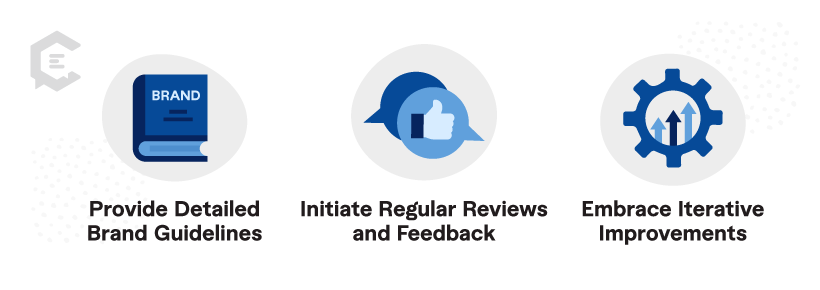Marketers and freelancers are dance partners in the creation of excellent content. Whether you’re a natural or have two left feet, finding a shared rhythm when managing freelance writers is essential to success. When both parties are in sync, the result is a seamless blend of information and creativity that captivates audiences and drives brand visibility.
However, the misalignment of expectations between marketers and freelance writers often trips up everyone involved, leading to dissatisfaction and missed opportunities.
This guide aims to help you manage your expectations and fine-tune a writer’s work, ensuring an efficient and mutually beneficial relationship. By providing a clear roadmap of expectations and guidance, you can ensure a productive relationship with freelance writers that not only optimizes their talents but also elevates your brand’s content quality.

Understanding the ClearVoice Perspective
At ClearVoice, we believe in the profound role freelance content creators play in helping marketers grow their content marketing programs.
That said, in our experience, the magic only happens when there’s a clear alignment between what you anticipate and what the freelance creator delivers. When managing freelance writers, understanding expectations is crucial in optimizing outcomes. This involves a number of critical components, most importantly:
- Setting clear, realistic goals
- Creating shared expectations
- Providing detailed briefs
- Maintaining open lines of communication
- Establishing robust feedback mechanisms
This alignment doesn’t merely streamline the content creation process. It fosters a mutually beneficial relationship where writers feel valued and understood, leading to better engagement and a higher-quality content product in the long run.
The Dynamic Nature of Content Types and Expectations
Content varies in its readiness upon delivery, ranging from 100% publish-ready to drafts that need further refinement. To illustrate this, we will explore real-life examples and discuss strategies to set clear expectations and derive the best from your freelancers.

Setting Expectations: When is Content 100% Ready?
When we talk about industry-focused blogs, the expectations are often set high. This is primarily because these pieces serve as the brand’s voice to the outside world, catering to a broad audience base and aiming to pull them into the sales funnel. They are typically informative and geared toward raising awareness and establishing your brand as an industry thought leader. Therefore, these pieces must be well-researched, engaging, and error-free upon delivery.
But let’s be real in setting expectations here. Achieving 100% ready status out of the gate requires meaningful upfront work — from setting clear parameters for the piece, providing detailed outlines or bullets, and ensuring that your freelance writers have an experience that aligns with your preferences and the expertise necessary to write for your brand.
When each of the above is achieved, and there is a thorough review process in place, a polished and ready-to-publish article should ideally be the outcome. This is especially true for top-of-funnel content, where the information is mostly industry-specific and doesn’t necessarily require deep insights into your products or services.

However, achieving this level of readiness often requires explicit guidelines from the marketer’s end. Here are a few tips to help guide writers toward delivering fully polished top-of-funnel content:
- Provide Detailed Briefs: Offer as much information as possible about the topic, the target audience, the tone, and the style of writing that matches your brand’s voice.
- Encourage Research: Stress the importance of thorough research before they start writing to ensure the content is accurate, relevant, and engaging.
- Foster Open Communication: Encourage them to ask questions if they’re unsure about anything in the brief or need further clarification on certain points. This preemptive measure can help minimize potential misunderstandings and unnecessary revisions.
- Set Up a Robust Review Process: Establish a systematic review process where drafts can be reviewed and feedback can be shared constructively. This can help refine the content and bring it closer to the 100% readiness mark.
By setting clear expectations and offering the right guidance, you can manage freelance writers to produce content that’s ready to captivate your audience and amplify your brand’s reach.

Expecting 80%: The Grey Zone of Content Readiness
When it comes to more intricate forms of content like newsletters and sales collateral, it’s essential to understand that they might necessitate further refinement even after delivery by a freelancer. These documents often require deeper knowledge of your specific products or services and the nuances of your brand’s voice and tone. This creates a gray zone where the content readiness is more likely to be around 80% at initial delivery, at least at the beginning.
Freelance writers, regardless of their skill level, are initially outsiders to your organization. They may need some time to fully grasp the intricacies of your product offerings, brand voice, and messaging style. As such, it’s unreasonable to expect a perfectly polished product or brand-specific document right out of the gate. Thus, we enter the zone of 80% readiness — a content piece that’s mostly complete but likely needs your touch to take it over the finish line.

Managing your expectations for 80%-ready content involves accepting that additional internal review and tweaking may be necessary. But how do you effectively navigate this gray zone? Here are some techniques:
- Provide Detailed Brand Guidelines: Ensure your freelance writer has access to detailed information about your products and comprehensive brand guidelines. These resources are invaluable for helping them understand your brand’s unique characteristics and voice.
- Initiate Regular Reviews and Feedback: Establish a review and feedback process where you provide constructive suggestions to improve the content’s alignment with your brand. This will help the writer learn and adapt their writing to your brand’s requirements.
- Embrace Iterative Improvements: Understand that it’s a process. While the initial drafts might hit the 80% mark, continuous collaboration with the writer will bring subsequent content pieces closer to 100% readiness.
Enhancing a writer’s understanding of your brand isn’t an overnight process. It involves consistent communication, feedback, and patience. As they get more familiar with your brand and its unique needs, you’ll notice an upward trend in content readiness, eventually minimizing the gap between that initial draft and a fully polished, ready-to-publish piece.

The Rubric: A Guideline to Train and Retain Freelance Writers
An effective way to align expectations and improve freelance writers’ work is to implement a rubric. In this context, a rubric is a guideline or framework that outlines the quality standards and specific criteria your brand expects from the content. It provides a roadmap for the writers to follow and serves as an objective assessment tool to evaluate the work submitted.
So, what does a content rubric look like, and what should it include? Essentially, it should contain clearly defined criteria for evaluating content quality. These criteria could include:
- Accuracy and relevance of information
- Clarity of writing
- Adherence to brand voice and tone
- Industry/company compliance guidelines
- SEO optimization
- Any other elements critical to your content strategy
Each criterion should be associated with a rating scale, which helps measure the level of achievement. For example, you might have a scale ranging from “below expectations” to “exceeds expectations” for each criterion.
Beyond serving as a guide for writers, the rubric is an excellent tool for facilitating feedback and communication. Instead of vague or subjective feedback, you can use the rubric to provide writers with specific, measurable insights about where they excel and where they need to improve.
By making your expectations clear and transparent, you’re enabling the freelance writers you’re managing to meet those expectations more effectively. This leads to improved content quality and helps build stronger, long-term relationships with your freelance writers. In the long run, a content rubric can be instrumental in training, refining, and retaining freelance writers who consistently deliver content that aligns with your brand’s needs and expectations.

Why Perfection is Not the Aim: Understanding the First Draft
Regarding freelance writing, perfection should not be the target, especially for the first draft. This might sound counterintuitive, but let’s consider this: Writing is a process, and the first draft is merely the first step. The expectation of perfection on the first try may not only put undue pressure on the writer but may also limit their creativity and hinder the evolution of ideas.
Having a constructive approach when the first draft doesn’t meet the mark is essential. Focusing on the positives, pointing out areas of strength and needing improvement. Criticism should always be constructive. Using the rubric can be helpful.
Developing high-quality content is a collaborative process that evolves. The writer learns more about your brand’s voice, audience, and goals with each piece of feedback you provide and every piece of content they produce. Patience allows for this learning curve and builds a stronger working relationship. Continued collaboration, open communication, and constructive feedback can turn that first draft from a rough sketch to a masterpiece that aligns with your brand and resonates with your audience.

Creating a Seamless Content Production Process
Setting realistic expectations and guiding your freelance writers properly can significantly enhance the quality of content, contributing to your brand’s growth. The principles presented will greatly benefit you and the freelance writers you’re managing by fostering healthier freelancer-client relationships.
Additional elements to consider include:
- Establishing clear internal alignment on content quality
- Creating a seamless revision process
- Assessing freelancer fit
- Clearly communicating content expectations
- Holding yourself accountable
Regular feedback sessions and comprehensive briefs will also significantly improve the content quality and reduce the need for revisions.
Remember, the ultimate goal is producing publish-ready content and fostering a harmonious relationship with your freelance writers, leading to long-term success and growth for your brand. Ready to kick-start your content? Talk to a specialist about getting started with your managed content production.



